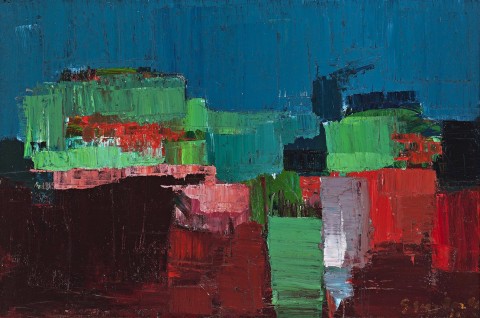SWAMP LANDS, 1972
GUY GREY-SMITH
oil and beeswax emulsion on muslin on composition board
60.0 x 90.0 cm
signed and dated lower right: G Grey Smith / 72
bears inscription verso: 24 / 66770
Private collection
Sotheby’s, Perth, 17 September 1990, lot 100
Private collection, Perth
A Festival of Perth Exhibition: Paintings by Guy Grey-Smith, The Old Fire Station Gallery, Perth, 24 February – 16 March 1977, cat. 24
Gaynor, A., Guy Grey-Smith: Life Force, UWA Publishing, Perth, 2012, p. 266
Swamp Lands, 1972, is a key painting from Guy Grey-Smith’s oeuvre marking a point of renewal for the artist following a period of intense personal trauma. It is also highly likely to be one of the first oil paintings he did in the region around Pemberton, a timber industry town in south-west Western Australia that was to become his home for the final years of his life. It is a land thick with Karri trees soaring over a tangled understorey, where patches of blazing light pierce the otherwise dense canopy; and there are extensive swamps in the vicinity of the Warren River which flows through the forests beyond the township. All these contrasting elements may be interpreted as inspiration for this painterly tapestry of interlocking, high-colour planes.
In 1969, Grey-Smith and his artist-wife Helen travelled to Cambodia where he was invited to take up the position of Professor of Fine Arts at Phnom Penh University. Tragically, this appointment was to have a catastrophic effect on him due to a political coup six months after their arrival, an upheaval related to the concurrent Vietnam War. The couple soon became unwilling spectators to atrocities, gunfire and disappearances which reignited debilitating memories for the artist of his own experiences as a P.O.W. during World War II.1 On returning to Perth, and almost incapacitated by Post-Traumatic Stress, Grey-Smith spent the greater part of the next two years painting in acrylics and making silkscreen prints with only staggered attempts at larger works in oil. Seemingly uncertain of his ability to reconnect with his previous artwork methods, this alternate strategy of exploring different mediums actually opened up new possibilities that he glimpsed in the process. Following the psychologically healing encounter with the forests of Pemberton, his revived optimism is evident in a small body of oil paintings executed in the latter half of the year. To date, only ten oils from 1972 have been identified, mostly depicting plants and still lives, but three, including the work on offer here, are directly related to the region around the township.2 At first glance, Swamp Lands appears to be simply a richly coloured field of interlocked pigment, but as the artist-critic James Gleeson noted, ‘(Grey-Smith) is at his best when the visual starting point is most remote from the final effect – when one reads the work as an abstract before realising its figurative implications’.3
It is apparent that Grey-Smith kept the painting in his studio for some years for contemplation as he was soon overtaken by the demands of a proposed retrospective curated by the Art Gallery of Western Australia;4 and the next years saw masterwork after masterwork tumble from his hands. In 1977, he exhibited Swamp Lands at a Festival of Perth exhibition held at Rie Heyman’s Old Fire Station Gallery, ‘an ambitious show … and admirers still talk today of the “glorious colour which seemed to pour out of the gallery as we walked up the street”’.5 Only one other landscape oil painting from the 1970s has appeared on the Australian auction market in the past five years, indicative of the close connection and enjoyment that owners continue to feel for these evocative works.
1. For more detail on these experiences, see: Gaynor, A., Guy Grey-Smith: life force, UWA Publishing, Perth, 2012, chapters 1 and 5
2. The other two from 1972 are Karri forest II and Untitled (Karri trees), both in private collections.
3. Gleeson, J., ‘Subtracting from Reality’, Sun, Sydney, 12 July 1972, p. 66
4. Guy Grey-Smith Retrospective, Art Gallery of Western Australia, Perth, 11 November – 12 December 1976; Queensland Art Gallery, Brisbane, 13 January – 15 February 1977
5. Chen V Thomas, 2010, quoted in Gaynor, A., op cit., p. 104
ANDREW GAYNOR
